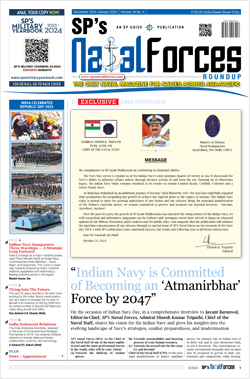INDIAN ARMED FORCES CHIEFS ON OUR RELENTLESS AND FOCUSED PUBLISHING EFFORTS

The insightful articles, inspiring narrations and analytical perspectives presented by the Editorial Team, establish an alluring connect with the reader. My compliments and best wishes to SP Guide Publications.

"Over the past 60 years, the growth of SP Guide Publications has mirrored the rising stature of Indian Navy. Its well-researched and informative magazines on Defence and Aerospace sector have served to shape an educated opinion of our military personnel, policy makers and the public alike. I wish SP's Publication team continued success, fair winds and following seas in all future endeavour!"

Since, its inception in 1964, SP Guide Publications has consistently demonstrated commitment to high-quality journalism in the aerospace and defence sectors, earning a well-deserved reputation as Asia's largest media house in this domain. I wish SP Guide Publications continued success in its pursuit of excellence.
- MoD initiates comprehensive review of Defence Acquisition Procedure 2020, pushes for defence reforms
- G7: The Swansong
- Kalinga Connect: South Asia to Polynesia
- Advanced MRSAM for India for a greater firepower
- Must Credit DRDO for Operation Sindoor, now what is next for defence R&D?
- Operation Sindoor | Day 2 DGMOs Briefing
- Operation Sindoor: Resolute yet Restrained
Technology
A Continuous Evolution: The Standard Missile-6

The Standard Misile-6 was originally developed to defend ships against enemy aircraft, unmanned aerial vehicles and cruise missiles. Over the last four years, the missile has become a shining example of missile defense evolution.
The missile is somewhat new – first issued to the US Navy fleet in 2013. By 2015 it had successfully added and proven the ability to protect ships against ballistic missile threats in their final phase of flight. A handful of months later, it demonstrated the ability to take out objects on the ocean’s surface. A test in January of 2016 resulted in the demise of the decommissioned USS Reuben James. In recent tests it has shattered its own record several times over for the longest range surface-to-air intercept of its kind in naval history. Three missions in one missile is remarkable, unprecedented really, but just as impressive is the fact that these new missions are added to an existing missile through software upgrades only. There is literally no physical change to the missile, and it is part of Raytheon’s effort to rapidly spiral capability into the hands of service commanders.
A complex series of US Navy flight tests in April 2017 proved that the SM-6 was ready to reach the final stage of the acquisition process: full operational capability. Reaching this phase is a type of graduation exercise that signifies the weapon’s sea worthiness and that no more testing is required. The missile is fully ready for deployment at sea with all three missions – anti-air warfare, anti-surface warfare and ballistic missile defense.
The evolution of these missiles, and others that Raytheon produces, is intentional. The rapid development of technologies is only able to occur when you have a robust base of engineering, production, and testing expertise to build upon – a more than 60 year legacy within the Standard Missile family makes a solid base.
Few missiles are started from scratch. Over the years, Raytheon has taken the best components of the best systems to create versatile powerhouses like the SM-3 and the SM-6. The SM-3 program has leveraged lessons learned during years of testing. The SM-6 program incorporates advanced signal processing and guidance control capabilities of Raytheon’s Advanced Medium-Range Air-to-Air Missile. The SM-6 design is also based on the time-tested advantages of the Standard Missile’s airframe and propulsion.
In early 2017, the US Department of Defense approved the release of SM-6 to several international customers. Many of the approved countries are seeking the multimission missile to bolster their shipbuilding programs. The flexibility of the missile drives significant cost savings for US partners and allies.
The technology of the Standard Missile family has expanded from defending ships to defending continents. Thanks to the innovation and foresight of industry and government teams, the Standard Missile will continue to evolve and advance.





